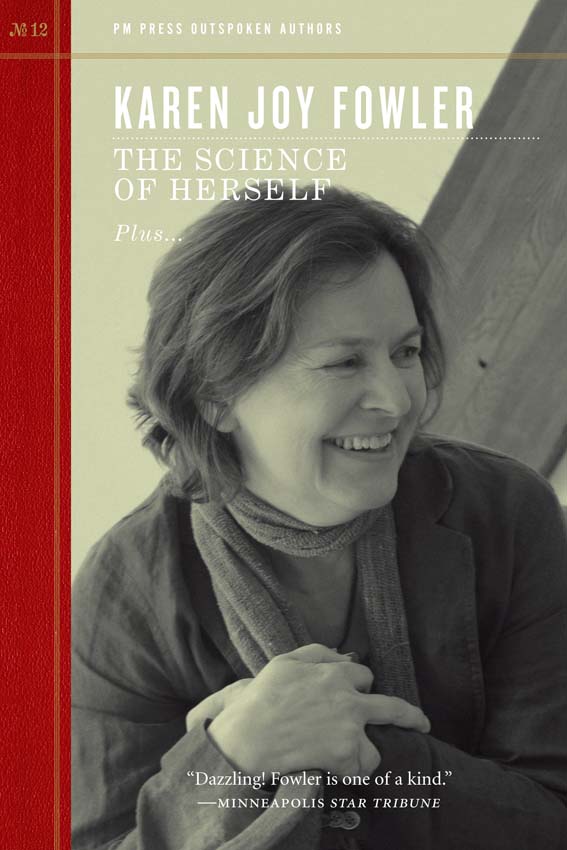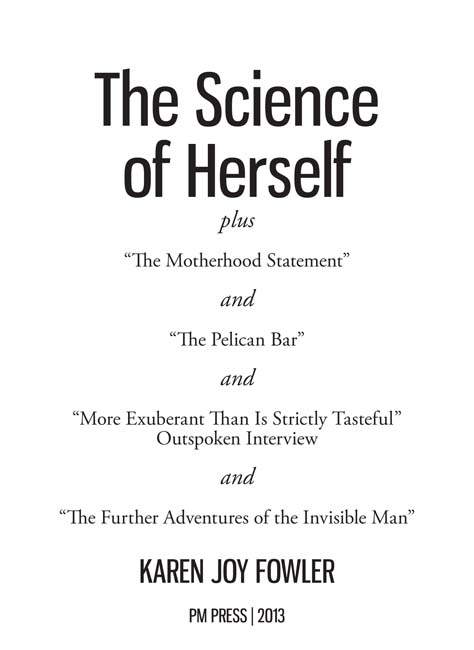The Science of Herself
Read The Science of Herself Online
Authors: Karen Joy Fowler


Winner of the World Fantasy Award
Shirley Jackson Award
Nebula Award
Commonwealth Award
“Unforgettable ⦠incandescent ⦠bewitching.”
â
Los Angeles Times Book Review
“Highly imaginative ⦠In fine-edged and discerning prose, [Fowler] manages to recreate both life's extraordinary and its ordinary magic.”
â
New York Times Book Review
“Fowler's witty writing is a joy to read.”
â
USA Today
“An astonishing narrative voice, at once lyric and ironic, satiric and nostalgicâ¦. Fowler can tell stories that engage and enchant.”
â
San Francisco Chronicle
- The Left Left Behind
Terry Bisson
- The Lucky Strike
Kim Stanley Robinson
- The Underbelly
Gary Phillips
- Mammoths of the Great Plains
Eleanor Arnason
- Modem Times 2.0
Michael Moorcock
- The Wild Girls
Ursula Le Guin
- Surfing the Gnarl
Rudy Rucker
- The Great Big Beautiful Tomorrow
Cory Doctorow
- Report from Planet Midnight
Nalo Hopkinson
- The Human Front
Ken MacLeod
- New Taboos
John Shirley
- The Science of Herself
Karen Joy Fowler


Karen Joy Fowler © 2013
This edition © 2013 PM Press
Series editor: Terry Bisson
“The Pelican Bar” originally appeared in
Eclipse 3: New Science Fiction and Fantasy
(San Francisco: Night Shade Books, 2009).
“The Further Adventures of the Invisible Man” originally appeared in
Conjunctions 39: The New Wave Fabulists
(Annandale-on-Hudson, NY: Bard College, 2002).
ISBN: 978-1-60486-825-8
LCCN: 2013911521
10 9 8 7 6 5 4 3 2 1
PM Press
P.O. Box 23912
Oakland, CA 94623
Printed in the USA by the Employee Owners of Thomson-Shore in
Dexter, Michigan
Outsides: John Yates/Stealworks.com
Insides: Jonathan Rowland
“More Exuberant Than Is Strictly Tasteful” Outspoken Interview with Karen Joy Fowler
“The Further Adventures of the Invisible Man”
None but a woman can teach the science of herself.
âJane Austen
I
N 1814
, A
NNE
E
LLIOT
came to Lyme Regis and watched Louisa Musgrove fall from the steps of the breakwater onto the rocks below. It was late November, so even though the weather was good, the beach was empty of bathers and bathing machines. To their left, they could see the steep road spilling through the village, landing on the expanse of level beach. It was, Austen tells us, a vista both lovely and wonderful. The water was a dark Byronic blue. Seagulls wheeled in the air above them, shrieking. The air smelled of salt.
There might have been a scavenger or two, combing the tide-line for flotsam. Perhaps a fisherman had hauled his boat out, flipped it belly-up for repairs, and was hammering in the distance. Anne Elliot noticed none of these. Nor did she see a young girl, well known to the locals, selling snakestones, vertiberries, and devil's toenails from a stand. This girl might have identified the Elliot party as tourists, might have even been approaching them with a basket of curious rocks just in time to see Louisa fall.
Or not. Strangely dressed, lower class, odd in affect, and desperately poor, she was not really the kind of girl who wanders into an Austen novel.

In 1803, Austen herself had come to Lyme Regis and met this same girl's father. His name was Richard Anning. He was a cabinetmaker. Austen needed some repair work done on the lid to a box; he was recommended to her. We know these things because she found the price he asked so offensively high that she noted it in her diary.
Not noted: Richard Anning was a dissenter from the Church of England, a Congregationalist, and an outlier even there, an activist who'd organized a protest over the food shortages occasioned by the Napoleonic Wars and worked with the dominant church on issues of Poor Law.
Also not noted: his second career. Richard Anning was a fossil hunter. There is no mention of fossils in Austen's descriptions of the charms of Lyme Regis, yet it was said that smugglers could identify the beach in the dark simply by raking with their fingers through the sand. Two hundred million years ago, Lyme Regis lay at the bottom of a tropical sea, but no one knew this yet or would have believed it if they had.
Austen came again the following year. She and her sister Cassandra were uncommonly hardy, continuing their ocean bathing long into October. In 1804, they witnessed together the great fire that destroyed some fifty houses in Lyme.
Five years after Austen's second visit and five years before Anne's, Richard Anning died. He left behind a wife, two living childrenâa son, Joseph, thirteen at the time, and a daughter, Mary, tenâand eight dead and in the graveyard. Also a debt of £120. Within a year, the family was on parish relief.

Lyme's most notable manmade feature is the Cobb, the large wall of stone that curves around the harbor and has done so since at least 1328. The day they arrived, the Elliot party walked on top of the Cobb until they tired of the wind, and then descended to its shelter by a particularly steep set of stairs known as Granny's Teeth. They talked of poetry and ships, war and a young curate's prospects.
They stayed in Lyme only one night. Many of the inns and boarding houses, the indoor baths and the Assembly Rooms were closed. In the summer, they might have gone into the sea, a bell ringing to warn men to stay away as the ladies bathed. In November, Lyme had dwindled to its actual residents. Winter was the wrong season for tourists.
Winter was the season for fossil hunting. Ninety-five miles of crumbling cliffs stretch like wings on either side of Lyme Regis. These cliffs contain shale, lime, and sandstone in an unstable proportion particular to Lyme and called the Blue Lias. In the winter, storms strip and shift the terrain, exposing new bits of cliff face, tumbling old bits back into the sea. A fossil can appear after one storm, scrubbed free by the wind and rain, only to disappear again after the next. Diligence and persistence are required, but also courage. There can be no waiting for the weather to clear, no waiting for the tides to recede. The fossil hunter must wade and climb. Landslips are common, the waves treacherous.
The chief peril is the hanging cliffs. At any moment they may give, crushing anyone underneath. Later in her life, Mary Anning's beloved dog Tray was killed in just this way only a few feet from where she stood. Richard Anning was often criticized for taking his children into this dangerous terrain; he did so even on the Lord's Day. He himself had at least one serious fall and the resulting injuries usually share the blame with tuberculosis for his early death.
That young Joseph and Mary continued this work without himâthat their mother, who had already lost so many of her children, allowed itâshows how desperate their finances were. Mary made her first sale in the period just after her father died. A Londoner gave her half a crown for a very fine ammonite, enough to feed them for a week. She was eleven years old.
Sometime later that same year, her older brother Joseph found a massive ichthyosaurus skull in a fallen rock. The skull measured almost four feet from snout to neck. He called Mary to come and see and they knelt together in the whipping wind and rain. The sockets of its eyes were twelve inches across.
The children were used to not knowing what it was that they had found. Ammonites were called snakestones because people thought they might be petrified snakes. Belemnites were caused by lightning and known therefore as thunderbolts. The world was vast and mysterious and no one knew how it was about to tip over.
But Mary had never seen a fossil so big as this one. What did she think as she looked into the eye sockets of that enormous skull? Did she suddenly wonder if the bay was still hiding other such beasts, beasts alive and hunting? That when she waded in the tidewaters, searching for her stones, those enormous, predatory eyes were watching her legs? Or did she already know more than enough about monstersâher life so hard, her heart so full of grief? She had been very close to her father.
Did she see only the money such an object would bring?
We do know what Joseph thought. He thought that fossil hunting was not for him and from then on he mostly left it to his little sister. He apprenticed as an upholsterer, trading any present income for future earnings. By the time those occurred, he would be married with a child of his own.
